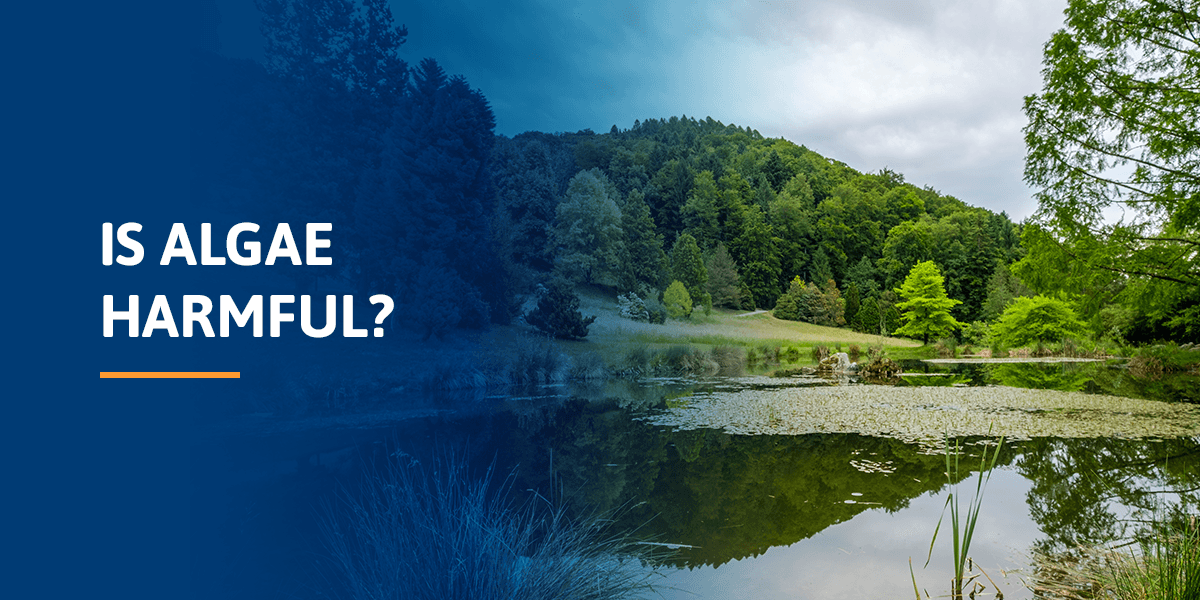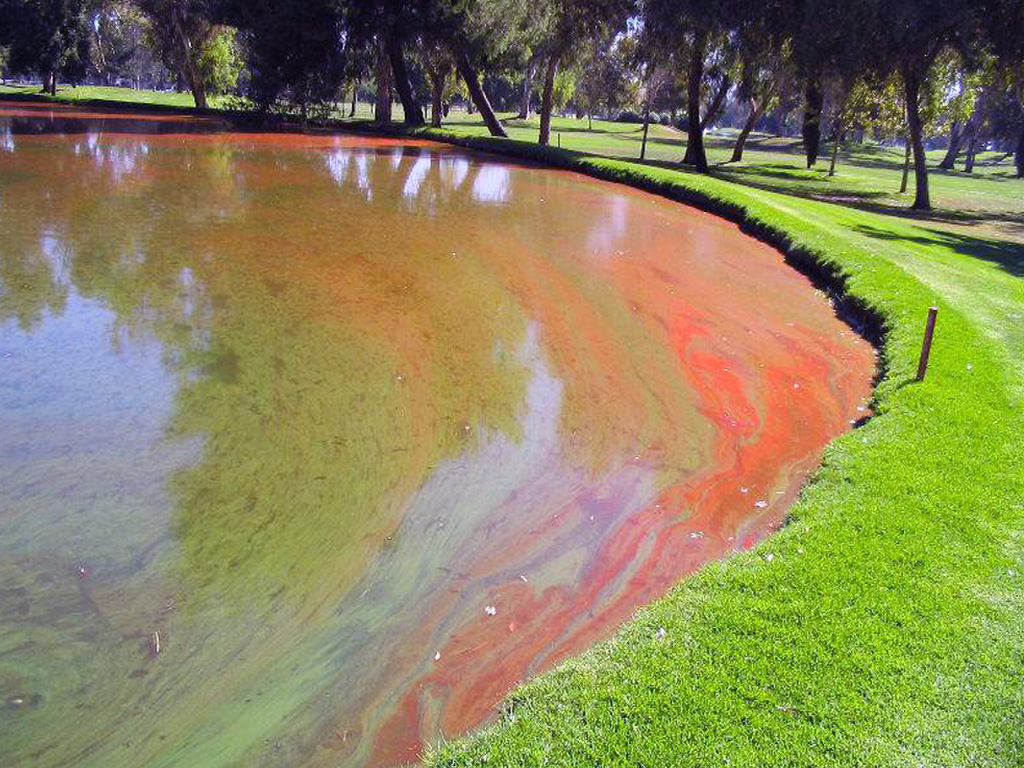Is Algae Harmful?
Like many other frequently asked questions we receive, there isn’t a straight answer to this question. There are various kinds of algae, and each can affect people and animals differently. Algae’s impact on humans, animals and other plants also depends on the quantity.
To know if the algae in your pond is potentially harmful, it’s important to first identify the type of algae it is. In addition, it’s always best to mitigate risks by having a professional take a look a provide a recommendation to minimize and control algae growth.
Request a Consultation
Common Types of Algae to Know
Algae growth is one of the most common problems in a lake or pond. There are many algae species, often categorized by color. The primary reason algae grow in different colors is the photosynthetic pigments present. In slow-moving, warm and nutrient-rich water, algae may proliferate, causing an algae bloom. Some of the most common algae colors include red, green and brown.
- Red algae: Red algae, also known as Rhodophyta, commonly include many seaweeds and other algae forms with a bright red color. Red algae blooms get their color from phycoerythrin, a photosynthetic pigment. Red algae also contain chlorophyll a, chlorophyll and phycocyanin. Red algae may form deeper in your pond because of their ability to absorb blue light. While some red algae are not toxic, you should always be cautious until you can identify the algae bloom. Harmful algae blooms can adversely affect marine life and may even be hazardous to humans in some cases. Despite their name, red algae are not technically algae, but their development and growth are similar to planktonic algae.
- Green algae: Green algae, often called Chlorophyta, develops in marine and freshwater habitats. Some green algae may also live in the moist soil surrounding a pond. Green algae have three types of cellular organization patterns — colonial, unicellular and multicellular. In many cases, unicellular green algae have flagella for improved motility. Colonial types of green algae include Hudrodictyon and Volvox. Some kinds of green algae, including Chlorella, are non-motile. Some blue-green algae blooms may produce toxins. Exposure to toxic blue-green algae blooms can harm aquatic life and humans if they swallow or touch the water. Toxic green algae blooms can create airborne droplets, which are dangerous if inhaled.
- Brown algae: Brown algae, known as Phaeophyta or dusky plants, have a brownish yellow color due to a combination of various photosynthetic pigments, including chlorophyll c, chlorophyll a, xanthophylls and fucoxanthin. Many types of brown algae that form in ponds adhere to the walls with calcium. Often, brown algae survive with poor light and few nutrients. In some cases, brown algae develop root-like structures known as holdfasts that help them anchor to the substrate. Brown algae may release toxins when they die. These can cause illness in humans and aquatic life. In general, if algae proliferates, you should avoid touching the water.
There are three primary types of algae — filamentous, macrophytic and planktonic. Often, algae that become a nuisance are of the filamentous variety.
- Filamentous algae: This type of algae usually grows on the bottom of the pond. As it grows, the hair-like strands of algae interweave like a web or tangled hair to form larger mats. These mats become buoyant as they grow and photosynthesize, eventually filling with air and floating to the surface. This type of algae is prevalent in ponds and can be very unsightly. Many species of filamentous algae that grow throughout the season.
- Macrophytic algae: Similarly, these algae also typically grow near the bottom of a waterbody and resemble a vascular plant. The two common types of macrophytic algae are chara and nitella. However, macrophytic algae are tough to identify and often get mistaken by pond owners as other types of common aquatic plants. It almost always takes an aquatic expert to identify this type of algae.
- Planktonic algae: These microscopic algae cells float freely in the water column. At low density, planktonic algae are usually not easily visible in the water. However, when enough cells grow in the water column, they come together to form groups of green scums that resemble paint or give water that “pea soup” look.
1. Filamentous Algae and Macrophytic Algae Health Concerns
Filamentous algae can grow abundantly in water bodies with excess nutrients. However, the most significant harm these algae cause is being unpleasant to look at and causing pond odor. Filamentous algae don’t usually pose any risk to humans or animals. When only filamentous algae are present in a body of water, it is safe for people and animals to be in and around.
However, if the look or smell of algae bothers you, our team at AEC would suggest controlling the growth of algae to make water recreation more appealing for you and anyone else who uses it. EPA-registered algaecides can control most of this type of algae. Similarly, macrophytic algae can occasionally grow to nuisance levels but are not a cause of concern for the safety of animals or humans.
2. Planktonic Algae Health Concerns
Conversely, planktonic algae growth and its corresponding health risks for humans have been in the spotlight in the past decade. In 2014, Toledo, Ohio residents could not drink their tap water due to toxins from a harmful algal bloom on Lake Erie. In the past few years, Florida has made headlines due to the explosion of red tide, a planktonic algae type, and the massive bloom of blue-green algae along the Florida coast and in Lake Okeechobee.
Planktonic algae blooms are especially dangerous because they can plague anything from small ponds to large lakes with excess nutrients. Most species of this algae do not pose a threat to organisms. However, some planktonic algae species produce harmful toxins that can affect humans and animals. The most common toxin causing recent concern is called microcystin. Microcystins are a group of toxins produced by several species of cyanobacteria.
Cyanobacteria, better known as blue-green algae, as they are commonly referred to, can accumulate in ponds and lakes when conditions are ideal and blooms occur. Microcystin toxins are the most common type of toxin produced by cyanobacteria and planktonic algae. Recent research suggests that microcystins can have negative health effects on the human kidneys, liver and reproductive function in men and women. Microcystins can also be less permanent irritants for throats, eyes and skin.
3. Microcystin Health Precautions
People have reported a wide range of microcystin concentrations in lakes and reservoirs, ranging from non-detectable to upward of 10,000 µg/L. When the microcystin toxin is present, it can cause concentrations from <1 to 100 µg/L, depending on the specific algae present and the cell density. After the incident in Ohio, state officials quickly reacted and set new guidelines for what they determined to be safe levels regarding the recreational use of water containing microcystins. Their guidelines are as follows:
- Levels above 6 µg/L trigger a public health advisory. People should not swim or wade, swallow water or touch surface scum.
- Levels above 20 µg/L trigger a no-contact advisory. It is recommended that the public avoid all contact with the water.
The EPA has recommended a microcystin level of 8 µg/L or less for recreational water use. However, not all states have set guidelines for recreational use of water containing harmful toxin levels. We hope and expect to see more state water safety directives in the future. For now, if you see a bloom in the water and want to be cautious for pets, children and yourself, we recommend following the adage “Better safe than sorry.”
Contact AEC About Algae Control for Your Pond
If your pond has a large buildup of algae or you suspect that you may have toxic algae blooms, contact AEC today for a consultation with one of our pros on a custom pond management plan. Call us today or request a consultation online.





8 Comments
Add Comment